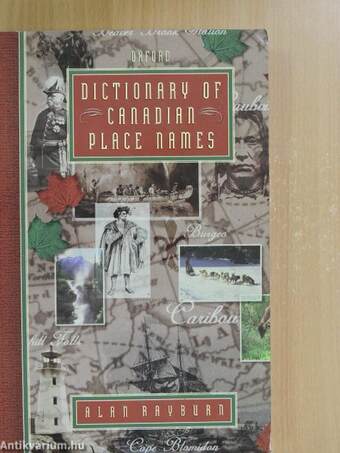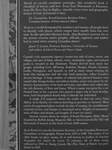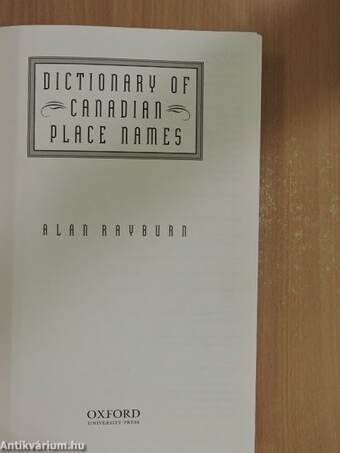1.104.328
kiadvánnyal nyújtjuk Magyarország legnagyobb antikvár könyv-kínálatát

VISSZA
A TETEJÉRE
JAVASLATOKÉszre-
vételek
Dictionary of canadian place names
| Kiadó: | Oxford University Press |
|---|---|
| Kiadás helye: | Oxford |
| Kiadás éve: | |
| Kötés típusa: | Ragasztott papírkötés |
| Oldalszám: | 461 oldal |
| Sorozatcím: | |
| Kötetszám: | |
| Nyelv: | Angol |
| Méret: | 23 cm x 15 cm |
| ISBN: | 0-19-541470-5 |
naponta értesítjük a beérkező friss
kiadványokról
naponta értesítjük a beérkező friss
kiadványokról
Fülszöveg
'Based on careful, consistcnt principles, ihis vvonderful book is chockfull of history and lore. From East Wawanosh to Ebenezer, from Mt Terry Fox to Zephyr, virtually every town and geographic featurc of note in Canada is here.' J.L. Granatstein, Rowell Jackman Resident Fellow, Canadian Institute of International Affairs 'Even in a world dominated by numbers and money, all people have to identify with places, whose origins have mostly been lost over time. In this splendid reference book, Alan Rayburn recovers for us the serious reasons native peoples, offtcials, explorers and settlers had in mind when naming Canadian places.' James T. Lemon, Professor Emeritus, University of Toronto and author of Liberal Dreams and Nature's Limits Canada's rich toponymic tapestry-names not only of cities, towns, and villages, but alsó of lakes, islands, rivers, mountains, capes, and national parks-is revealed in this dictionary. Names derived from many languages, including Cree, Mi'kmaq, Inuktitut,... TovábbFülszöveg
'Based on careful, consistcnt principles, ihis vvonderful book is chockfull of history and lore. From East Wawanosh to Ebenezer, from Mt Terry Fox to Zephyr, virtually every town and geographic featurc of note in Canada is here.' J.L. Granatstein, Rowell Jackman Resident Fellow, Canadian Institute of International Affairs 'Even in a world dominated by numbers and money, all people have to identify with places, whose origins have mostly been lost over time. In this splendid reference book, Alan Rayburn recovers for us the serious reasons native peoples, offtcials, explorers and settlers had in mind when naming Canadian places.' James T. Lemon, Professor Emeritus, University of Toronto and author of Liberal Dreams and Nature's Limits Canada's rich toponymic tapestry-names not only of cities, towns, and villages, but alsó of lakes, islands, rivers, mountains, capes, and national parks-is revealed in this dictionary. Names derived from many languages, including Cree, Mi'kmaq, Inuktitut, Basque, French, Germán, Gaelic, Portuguese, and Spanish, as well as many names echoing the lands that immigrants had left with fond memories, reflect Canada's diverse heritage. A large number of cultural and physical features were named after foreign batdes and military leaders, many were given for distinctive characteristics of die land and water, and others were called after the rich diversity of flóra and fauna. Where a name was given for a celebrated hero or for a person who played a major role in local development, brief biographical details help to identify the individual. A single A-Z sequence allows the reader to find any entry, from Abbey, sk to Zürich, on without knowing its province or territory. Most entries for populated places include the date of naming, the establishment of postai service, and changes in municipal status. Heights of mountains, areas of lakes and islands, and lengths of rivers are noted. Anyone curious about the origins of South Porcupine, Dildo, HeadSmashed-in Buffalojump, Magnetic Hill, or Saint-Louis-du-Ha! Ha! will find much of interest in this book of over 6200 names. Alan Rayburn was the Executive Secretary of the Canadian Permanent Committee on Geographic Names from 1973 to 1987. The author of six other books on place names, he is well known to readers of Canadian Geographic for which he wrote 75 columns, 62 of them being collected in 1994 as Naming Canada. His Place Names of Ontario was published in 1997. VisszaTémakörök
- Idegennyelv > Idegennyelvű könyvek > Angol > Természettudományok > Földrajz
- Idegennyelv > Idegennyelvű könyvek > Angol > Helytörténet
- Idegennyelv > Idegennyelvű könyvek > Angol > Szótárak
- Helytörténet > Külföldi > Egyéb
- Szótárak > Szakszótárak > Tudományos > Egyéb
- Szótárak > Idegennyelvű szótárak > Angol
- Természettudomány > Földrajz > Általános gazdasági földrajz > Településföldrajz
- Természettudomány > Földrajz > Kontinensek földrajza > Topográfia szerint > Amerika
- Természettudomány > Földrajz > Idegen nyelv > Angol
Alan Rayburn
Alan Rayburn műveinek az Antikvarium.hu-n kapható vagy előjegyezhető listáját itt tekintheti meg: Alan Rayburn könyvek, művekMegvásárolható példányok
Nincs megvásárolható példány
A könyv összes megrendelhető példánya elfogyott. Ha kívánja, előjegyezheti a könyvet, és amint a könyv egy újabb példánya elérhető lesz, értesítjük.






